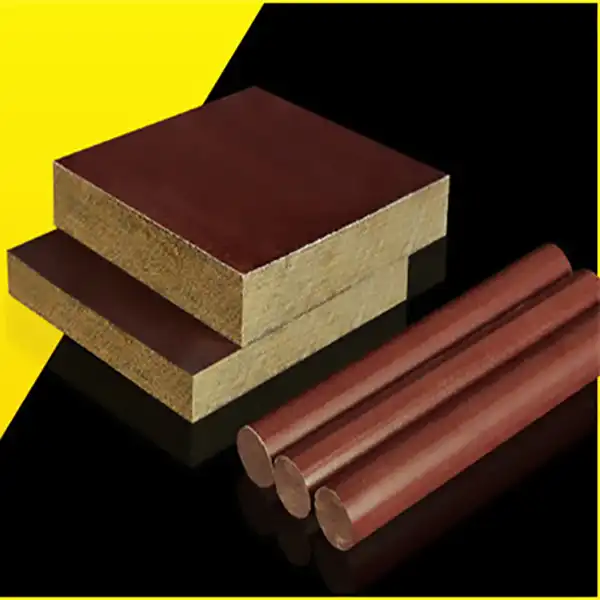Composition and Structure of Phenolic Cotton Laminates
Raw Materials and Manufacturing Process
Phenolic cotton laminates are engineered materials that combine the natural insulating properties of cotton with the durability and heat resistance of phenolic resins. The manufacturing process begins with the selection of high-quality cotton fabric, which serves as the base material. This fabric is then impregnated with phenolic resin, a synthetic polymer known for its excellent thermal and electrical insulating properties. The impregnation process ensures that the resin penetrates deeply into the cotton fibers, creating a robust and uniform composite material.
Once the cotton fabric is thoroughly impregnated, it undergoes a carefully controlled curing process. During this stage, heat and pressure are applied to the material, causing the phenolic resin to crosslink and harden. This curing process is critical in determining the final properties of the laminate, including its thermal resistance. The result is a dense, homogeneous material that combines the flexibility of cotton with the strength and heat resistance of cured phenolic resin.
Microstructure and Its Impact on Thermal Properties
The microstructure of phenolic cotton sheet laminates plays a significant role in their thermal resistance capabilities. At the microscopic level, the material consists of cotton fibers encapsulated in a matrix of cured phenolic resin. This structure creates numerous tiny air pockets and interfaces between the cotton fibers and the resin, which act as barriers to heat flow.
The cotton fibers themselves have a naturally low thermal conductivity, contributing to the overall insulating properties of the laminate. Additionally, the phenolic resin, once cured, forms a complex three-dimensional network that further impedes heat transfer. This combination of materials and structures at the micro level results in a macroscopic material with superior thermal resistance properties.
Chemical Bonding and Its Influence on Heat Transfer
The chemical bonding within phenolic cotton laminates is a key factor in their thermal resistance. The phenolic resin forms strong covalent bonds during the curing process, creating a rigid and stable structure. These bonds not only provide mechanical strength but also restrict the movement of molecules, which is essential for reducing heat transfer.
Moreover, the interface between the cotton fibers and the phenolic resin creates additional barriers to heat flow. The chemical compatibility between the cellulose in cotton and the phenolic resin ensures a strong adhesion, minimizing any gaps or voids that could potentially allow heat to pass through more easily. This intimate bonding at the molecular level contributes significantly to the overall thermal resistance of the phenolic cotton sheet.
Mechanisms of Thermal Resistance in Phenolic Cotton Laminates
Conduction, Convection, and Radiation Heat Transfer
Thermal resistance in phenolic cotton laminates is achieved through the material's ability to impede various modes of heat transfer. Conduction, which is the transfer of heat through direct contact between particles, is minimized due to the low thermal conductivity of both the cotton fibers and the phenolic resin. The discontinuous nature of the material's structure, with its numerous interfaces between fibers and resin, creates multiple barriers that heat must traverse, significantly reducing conductive heat transfer.
Convection, the transfer of heat through the movement of fluids or gases, is largely prevented in phenolic cotton laminates due to their solid structure. The dense composition of the material leaves little room for air movement within the laminate, effectively eliminating convective heat transfer within the material itself.
Radiation, the transfer of heat through electromagnetic waves, is also mitigated by phenolic cotton laminates. The opaque nature of the material and its ability to absorb and scatter infrared radiation contribute to its effectiveness in reducing radiative heat transfer. The phenolic resin, in particular, has properties that make it resistant to the transmission of radiant heat.
Role of Porosity and Density in Heat Insulation
The porosity and density of phenolic cotton laminates play crucial roles in their thermal resistance properties. Porosity refers to the presence of tiny air pockets within the material, which act as excellent insulators due to air's low thermal conductivity. In phenolic cotton sheets, a controlled level of porosity is maintained to optimize insulation without compromising structural integrity.
The density of the laminate is carefully balanced to achieve optimal thermal resistance. Higher density generally leads to improved mechanical properties and reduced porosity, which can enhance conductive heat transfer. However, an optimum density is sought that provides sufficient mechanical strength while maintaining the necessary level of porosity for effective thermal insulation. This balance is achieved through precise control of the manufacturing process, including the resin content and the pressure applied during lamination.
Effect of Temperature on Thermal Resistance Properties
The thermal resistance properties of phenolic cotton laminates are not constant but vary with temperature. Generally, as temperature increases, the thermal conductivity of materials tends to increase, potentially reducing their insulating effectiveness. However, phenolic cotton laminates are engineered to maintain their thermal resistance over a wide range of temperatures.
At lower temperatures, the material's thermal resistance is primarily due to its physical structure and composition. As temperatures rise, the phenolic resin's thermal stability comes into play, helping to maintain the material's insulating properties. The crosslinked structure of the cured phenolic resin resists softening or degradation at elevated temperatures, ensuring that the laminate retains its thermal resistance capabilities even in high-temperature environments.
Applications and Performance of Phenolic Cotton Laminates in Thermal Management
Industrial and Electrical Insulation Applications
Phenolic cotton laminates find extensive use in industrial and electrical insulation applications due to their exceptional thermal resistance properties. In industrial settings, these materials are often employed in high-temperature environments where maintaining thermal barriers is crucial. They are used in the construction of furnace linings, heat shields, and thermal barriers in manufacturing processes that involve extreme temperatures.
In the electrical industry, phenolic cotton sheets are prized for their combination of thermal and electrical insulation properties. They are used in the production of circuit boards, switchgear components, and transformer insulation. The material's ability to withstand high temperatures while maintaining electrical insulation makes it invaluable in applications where electrical equipment generates significant heat during operation.
Comparative Analysis with Other Insulating Materials
When compared to other insulating materials, phenolic cotton laminates often stand out for their balanced combination of properties. Unlike pure ceramic insulators, which may offer superior heat resistance but are brittle and difficult to machine, phenolic cotton sheets provide good thermal resistance while remaining relatively easy to work with and integrate into complex assemblies.
Compared to polymer-based insulators like polyurethane foams, phenolic cotton laminates offer better dimensional stability at high temperatures and superior fire resistance. While some advanced composite materials may offer higher absolute thermal resistance, phenolic cotton laminates often provide a more cost-effective solution that meets a wide range of industrial and electrical insulation needs.
Long-term Performance and Durability Considerations
The long-term performance and durability of phenolic cotton laminates in thermal management applications are significant considerations. These materials are known for their excellent resistance to thermal aging, maintaining their insulating properties over extended periods even when exposed to high temperatures. The phenolic resin's resistance to chemical degradation also contributes to the material's longevity in harsh industrial environments.
However, it's important to note that extreme conditions can eventually impact the performance of phenolic cotton laminates. Prolonged exposure to very high temperatures, beyond the material's specified limits, can lead to gradual degradation of the organic components. Regular inspection and replacement schedules are typically implemented in critical applications to ensure ongoing optimal performance.
Conclusion
Understanding thermal resistance in phenolic cotton laminates is crucial for their effective application in various industries. These versatile materials offer a unique combination of thermal insulation, electrical resistance, and mechanical strength, making them indispensable in many high-performance applications. The intricate structure of cotton fibers impregnated with phenolic resin creates a material with exceptional thermal resistance properties, capable of withstanding high temperatures while maintaining its insulating capabilities. As industries continue to seek efficient and reliable thermal management solutions, phenolic cotton laminates remain a go-to choice for engineers and designers aiming to optimize thermal performance in challenging environments.
Contact Us
Are you looking for high-quality phenolic cotton laminates for your thermal management needs? With over 20 years of experience in producing and selling insulating sheets, we offer expert guidance and top-notch products. Contact us today at info@jhd-material.com to learn more about our phenolic cotton sheets and how they can enhance your thermal insulation solutions.






